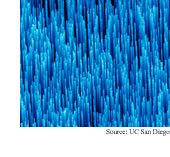|
NEWS
|
Biochip spots bad bugs
A biochip identifies pathogens in less than 30
minutes by analyzing the DNA in blood samples. The device
detected anthrax in infected mouse blood and Bordetella
pertussis in a patient with whooping cough. (A
Fully Integrated Microfluidic Genetic Analysis System
with Sample-in–Answer-out Capability, Proceedings
of the National Academy Of Sciences, December 19,
2006)
Pack takes some load off
An experimental backpack that coordinates its
up-and-down motion with the wearer's stride reduces the
effort of carrying the weight by 25 percent. The backpack
is a variation on a scheme that used the up-and-down motion
of the pack to generate electricity (Biomechanics:
Rubber Bands Reduce the Cost of Carrying Loads, Nature,
December 21, 2006)
Positively cheap nanowires
 It's possible to grow zinc oxide nanowires that
carry a positive electrical charge. Most zinc oxide nanowires
carry a negative charge. The addition of positive wires
opens a route to inexpensive light-emitting diodes and
other electronic devices. (Rational
Synthesis of p-Type Zinc Oxide Nanowire Arrays Using Simple
Chemical Vapor Deposition, Nano Letters, published
online December 29, 2006)
It's possible to grow zinc oxide nanowires that
carry a positive electrical charge. Most zinc oxide nanowires
carry a negative charge. The addition of positive wires
opens a route to inexpensive light-emitting diodes and
other electronic devices. (Rational
Synthesis of p-Type Zinc Oxide Nanowire Arrays Using Simple
Chemical Vapor Deposition, Nano Letters, published
online December 29, 2006)
Peptide gel nurtures cells
Modified peptides assemble themselves into a gel-like,
three-dimensional scaffold designed to grow cells. Mouse
neural stem cells cultured in the peptide scaffold grew
and differentiated into brain cells. The peptide scaffolding
could be used to culture replacement tissue and study
how cells work. (Designer
Self-Assembling Peptide Nanofiber Scaffolds for Adult
Mouse Neural Stem Cell 3-Dimensional Cultures, PLoS
One, December 27, 2006)
Superlenses coming into view
Visible light bends backwards when it travels
through a composite material containing nanoscale silver
mesh. Such negative-index materials could lead to superlenses,
which are flat lenses with greater magnifying power than
traditional curved lenses. (Negative-Index
Metamaterial at 780 Nm Wavelength, Optics Letters,
January 1, 2007)
Microdisk shoots blue beams
A laser made from a microscopic gallium nitride
disk requires much less power than previous microdisk
lasers and produces a continuous beam at room temperature.
The device is a step toward inexpensive blue lasers for
use in optical storage devices like ultrahigh capacity
DVDs. (Room-Temperature
Continuous-Wave Lasing in GaN/InGaN Microdisks, Nature
Photonics, January 2007) |
FEATURES
|
View
from the High Ground: ICL's John Pendry
Physics as machine tool, negative refractive
index, metamaterials, shattered wine glasses, higher capacity
DVDs, scientific backwaters, risk perception and practice,
practice, practice.
|
How
It Works: Quantum computing: qubits
Photons, electrons and atoms, oh my! These particles are
the raw materials for qubits, the basic building blocks
of quantum computers. |
|
 |
News RSS feed 
Blog RSS feed 
Bookshelf RSS feed

New: TRN's
Internet Services
TRN's Jobs Center
|
| |
|
| |
|
| |
"Physics
is to the rest of science what machine tools are
to engineering. A corollary is that science places
power in our hands which can be used for good or
ill. Technology has been abused in this way throughout
the ages from gunpowder to atomic bombs."
- John Pendry, Imperial College London |
|
| |
|
| |
Thanks
to Kevin from
GoldBamboo.com
for technical support |
|

